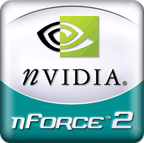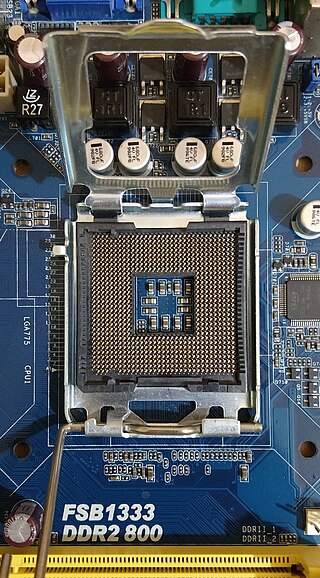
In computing, a northbridge is a microchip that comprises the core logic chipset architecture on motherboards to handle high-performance tasks, especially for older personal computers. It is connected directly to a CPU via the front-side bus (FSB), and is usually used in conjunction with a slower southbridge to manage communication between the CPU and other parts of the motherboard.

The southbridge is one of the two chips in the core logic chipset on older personal computer (PC) motherboards, the other being the northbridge. As of 2023, most personal computer devices no longer use a set of two chips, and instead have a single chip acting as the 'chipset', for example Intel's Z790 chipset.

The Nvidia nForce2 chipset was released by Nvidia in July 2002 as a refresh to the original nForce product offering. The nForce2 chipset was a platform for motherboards supporting AMD's Socket A CPUs along with DDR SDRAM. There were multiple variations of the chipset including one with an integrated GeForce4 MX graphics processor (IGP), and one without.

LGA 775, also known as Socket T, is an Intel desktop CPU socket. Unlike PGA CPU sockets, such as its predecessor Socket 478, LGA 775 has no socket holes; instead, it has 775 protruding pins which touch contact points on the underside of the processor (CPU).

The nForce3 chipset was created by Nvidia as a Media and Communications Processor. Specifically, it was designed for use with the Athlon 64 processor.
The Radeon Xpress 200 is a computer chipset released by ATI. The chipset supports AMD 64-bit processors as well as supporting Intel Pentium 4, Pentium D and Celeron processors. Additionally, it includes support for DDR400 RAM and DDR-2 667 RAM on the Intel Edition.
The nForce 500 is a motherboard chipset series and the successor to the nForce4 series. It was revealed by NVIDIA on 2006-03-07 and released on May 23, 2006. The nForce 500 series supports AMD's Socket AM2 and support for Intel's LGA 775 has also been added.
The Xpress 3200 is a revision of the Xpress 200 computer chipset released by ATI. The chipset supports AMD64 processors for Socket 939 and Socket AM2.
The AMD Quad FX platform is an AMD platform targeted at enthusiasts which allows users to plug two Socket F Athlon 64 FX or 2-way Opteron processors (CPUs) into a single motherboard for a total of four physical cores. This is a type of dual processor setup, where two CPUs are installed on a motherboard to increase computing power. The major difference between the platform and past dual processor systems like Xeon is that each processor has its own dedicated memory stores. The Quad FX platform also has HyperTransport capability targeted toward consumer platforms.
AMD 580 chipset series is a computer chipset series designed by the AMD Graphics Product Group, for the AMD processors. It was designed for usage with ATI's CrossFire Multi GPU Technology, with both PCI Express slots running at x16 lanes each.
NVIDIA System Tools is a discontinued collection of utilities for accessing, monitoring, and adjusting system components, including temperature and voltages with a graphical user interface within Windows, rather than through the BIOS.
The nForce 600 chipset was released in the first half of November 2006, coinciding with the GeForce 8 series launch on November 8, 2006. The nForce 600 supports Intel's LGA 775 socket and AMD's Quad FX platform and replaces the nForce 500 series.
The AMD 700 chipset series is a set of chipsets designed by ATI for AMD Phenom processors to be sold under the AMD brand. Several members were launched in the end of 2007 and the first half of 2008, others launched throughout the rest of 2008.
Skulltrail is an enthusiast gaming platform released by Intel on February 19, 2008. It is based on Intel's 5400 "Seaburg" workstation chipset. The primary difference between Skulltrail and Intel's current and past enthusiast chipsets is a dual CPU socket design that allows two processors to operate on the same motherboard. Therefore, Skulltrail can operate eight processing cores on one system. The platform supports two Core 2 Extreme QX9775 processors, which operate at 3.2 GHz.
The nForce 700 is a chipset series designed by Nvidia first released in December 2007. The series supports both Intel Core 2 and AMD Phenom processors, and replaces the nForce 600 series chipsets. Several members were spotted, including the codenamed MCP72 for AMD processors and the C72 for Intel processors, launched with the name "nForce 780a" and "nForce 780i" chipsets respectively. Currently, the released variants are the 750i, 780i, 790i, and 790i Ultra.
The AMD 800 chipset series is a set of chipsets developed by AMD, released in 2009. The chipset series was revealed in its presentation slides during the AMD Financial Analyst Day 2007 held on December 13, 2007. This chipset series also marks the return of AMD to the workstation/server market after the completion of the ATI acquisition in October 2006 with the first server chipsets.

The Intel X58 is an Intel chip designed to connect Intel processors with Intel QuickPath Interconnect (QPI) interface to peripheral devices. Supported processors implement the Nehalem microarchitecture and therefore have an integrated memory controller (IMC), so the X58 does not have a memory interface. Initially supported processors were the Core i7, but the chip also supported Nehalem and Westmere-based Xeon processors.

The AMD 900 chipset series is identical to the AMD 800 chipset series except for the fact that it is only found on Socket AM3+ mainboards, whereas its predecessor is only found on Socket AM3 mainboards. It was released in 2011.
Apollo VP3 is a x86 based Socket 7 chipset which was manufactured by VIA Technologies and was launched in 1997. On its time Apollo VP3 was a high performance, cost effective, and energy efficient chipset. It offered AGP support for Socket 7 processors which was not supported at that moment by Intel, SiS and ALi chipsets. In November 1997 FIC released motherboard PA-2012, which uses Apollo VP3 and has AGP bus. This was the first Socket 7 motherboard supporting AGP.

On June 26, 2007, Dell released the new Inspiron desktop series, under the Dell Inspiron branding, as a replacement to the Dell Dimension desktop computers.







